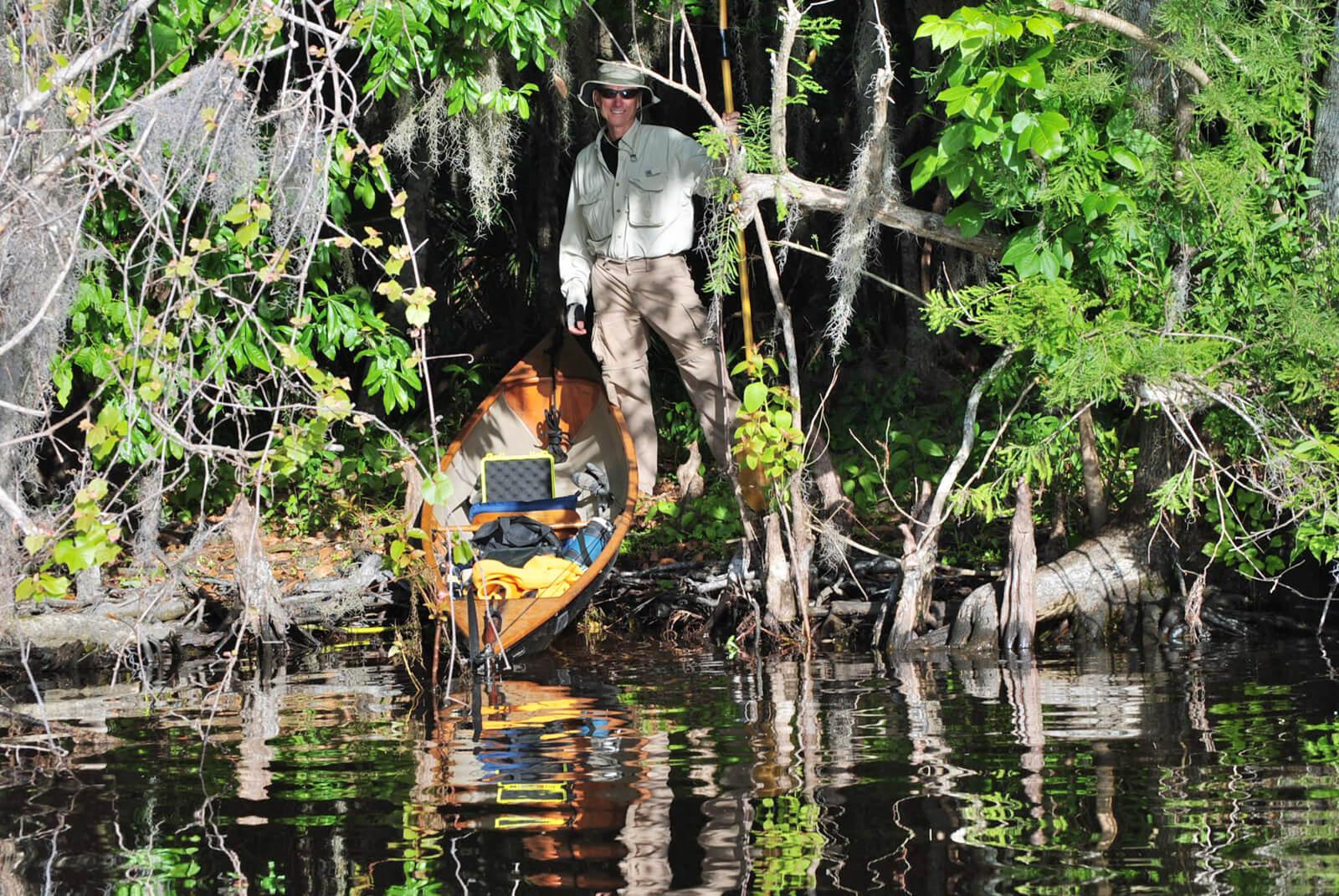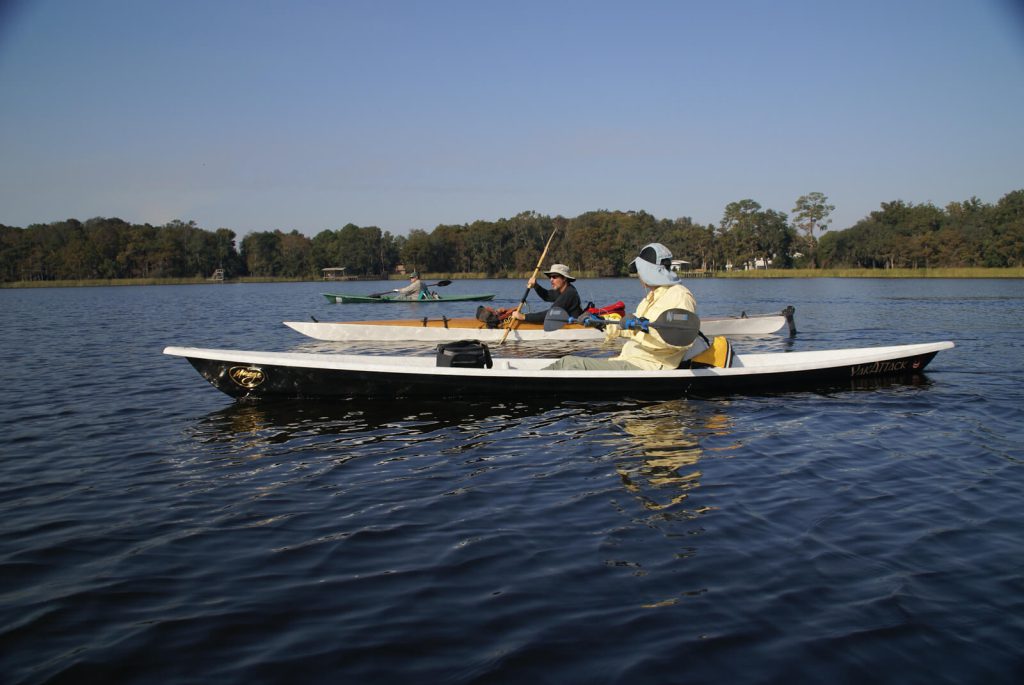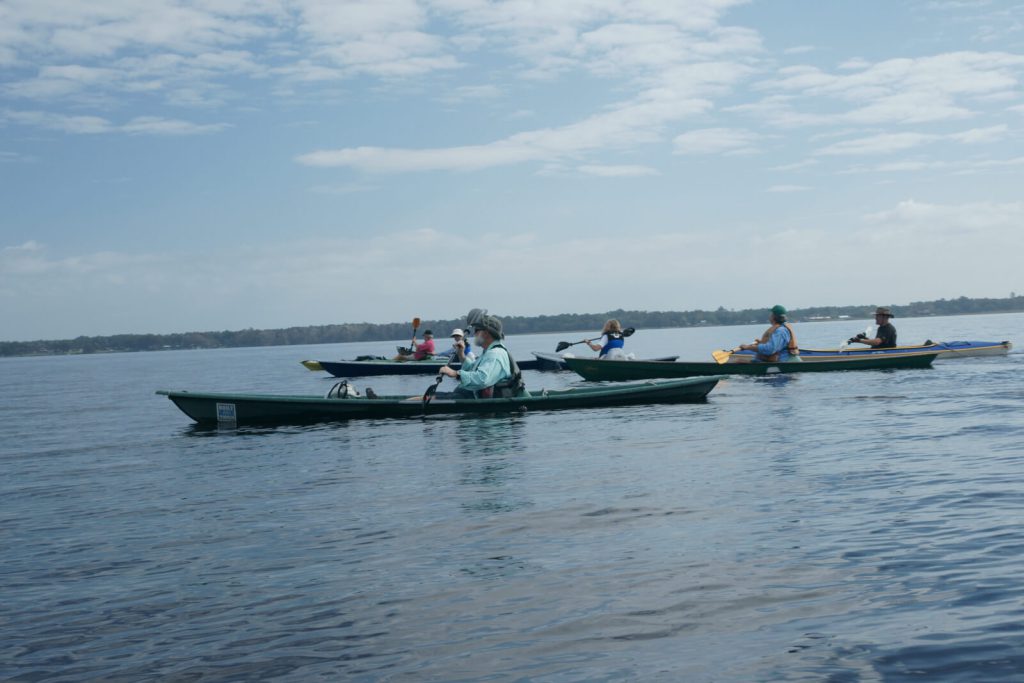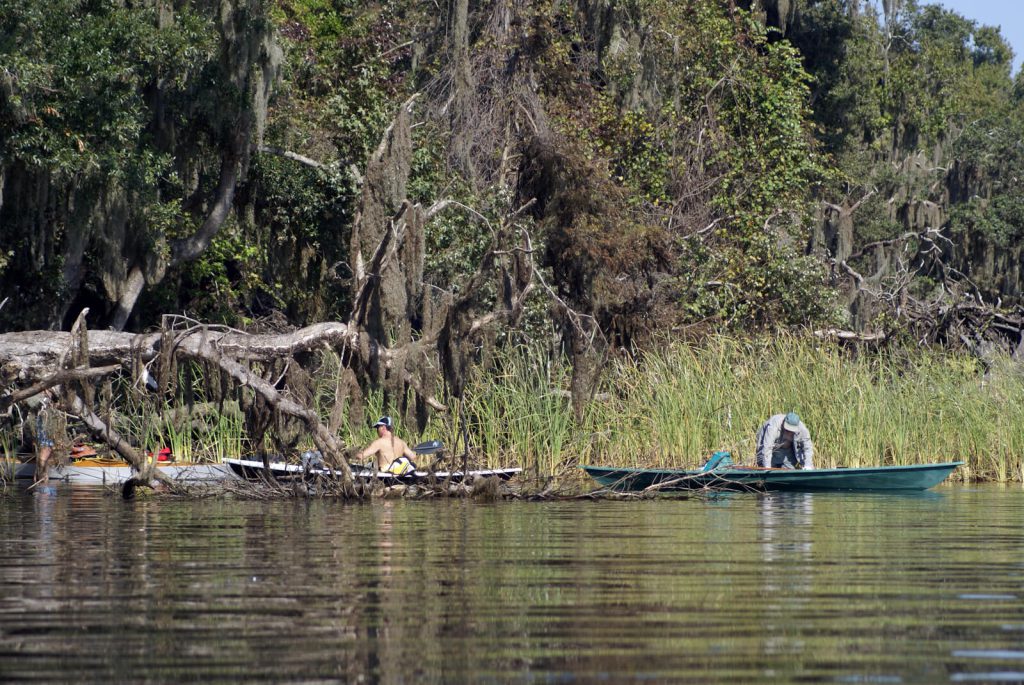02 Forrester Point
Putnam County


After several miles, [passing] by choice swamps near the river, we landed at a point of high ground, which has been an ancient plantation of Indians or Spaniards…
John and William Bartram
The Route
The Bartrams left Rollestown on the morning of January 30, 1766 and, after rowing 8 miles downstream, entered the mouth of Grays Creek (Rice Creek) on the west bank of the St. Johns. They rowed 7 miles up the Creek and back, making camp across the river on the east shore. On the morning of January 31, the Bartrams departed from their camp on the east shore of the St. Johns and headed down the river (north). They first crossed the river and followed the west shore for several miles, then crossed back to the east shoreline (Figure 1). On their previous passage, down river (south), they also hugged the west shore in this reach, probably because the east shore was well known and already under the ownership of Squire Roll. In this instance, is most likely because, according to the Journal, the north wind on this day was fresh and cold and the rowing would have been easier and passage more comfortable in the lee of the windward shore which has an east-west orientation in this reach. Once they rounded the point where the river bends to the north, they re-crossed and rowed along the east shore. After rowing along the eastern shore they entered “a great cove”; a perfect description of the cove at the mouth of Deep Creek (then named Observation Creek) and formed in the south by Federal Point and the north by Racy Point. They encamped “at a point…on middling high ground sloping towards the river.”
Based on John Bartram’s Journal entries for the 30th and 31st of January, it seems most likely that the route to and from this site were likely those portrayed in Figure 1. This route, leaving Rice Creek crossing the river to Forrester Point makes perfect sense after a long trip of what would have been in the neighborhood of 24 miles, if John’s estimates are correct. This location for this end point is further reinforced by the Journal entry for the 31st. It would have made perfect sense to cross directly north from Forrester Point to the west shore which would be sheltered from the NW wind that was blowing that day (Journal entry for February 1, 1766). Rowing several miles along this shore to a point opposite Federal Point makes a short crossing of the river and still leaves a short distance of upland to be coasted before entering the “great cove” formed by the mouth of Deep Creek between Federal and Racy points. This is a reasonable distance to cover during a day of rowing.
The Campsite
The location of the campsite used by the Bartrams on the night of January 30, 1766 cannot be pinpointed from the Journal text and several different sites have been proposed; sites as far north as Dancy and Federal points have been proposed by the authors of the Florida History Online website. While Dancy point seems reasonable, Federal Point seems unlikely for several reasons. Federal Point is nearly 8 miles from the mouth of Rice (Grays) Creek. It is unlikely that they rowed this distance having departed from Rollestown in the morning and traveled 7 miles up Rice Creek and back to the river. Secondly, had they been at Federal Point, there would have been no reason to cross the river on the morning of the 31st, in the face of a northwest wind, to row along the west shore only to cross back into “the great cove” which is undoubtedly that between Federal and Racy points. Finally, Federal Point was not within Roll’s 20,000 acre land grant (Figure 2), whereas the grove in which the Bartrams established their campsite was. It seems more likely that Federal Point was passed by altogether on the 31st and that the campsite was established nearer Racy Point, the location proposed by the authors of Florida History Online as the campsite for that night.
It seems most reasonable that the campsite was established at present-day Forrester (previously Forresters) Point (Figure 3). Having spent the day exploring Gray’s Creek, present-day Rice Creek, they crossed the river to this point of land jutting out into the St. Johns River on the east shore. John’s Journal describes the location as being within Mr. Roll’s land grant (Figure 3), and about 4 miles from his town by land and 8 miles by water. His description of the location, across the river from the mouth of Rice Creek, and estimates of the distances by land and water match perfectly given the route they most likely traveled to the mouth of Gray’s Creek then across to Forresters Point. The Journal describes making camp among the trees of a great orange grove.
They arose on the morning of the 31st, and departed, heading north without spending any time exploring; not unexpected given that they were in an orange grove, on land already claimed and surveyed in Mr. Roll’s land grant. This campsite was most likely their last in Putnam County as they headed down river towards the conclusion of their explorations on the St. Johns.
It should be noted that Francis Harper contends that Forrester Point is also the probable site of “an ancient plantation of Indians or Spanish” observed at a stop made during the upstream journey on December 25, 1766.
Forrester Point is located on the east shore where the River makes a 90 degree turn from north, northwest to almost due east. Viewed from the air, it is apparent that it is comprised of three lobes or “points” along its three-quarters of a mile width. It is impossible to say which of the three points (if indeed if the party chose a “point” at all) the Bartrams choose to make their landfall.
Bartram Trail Site Marker Number 2 is located on a piling in the River a few yards from shore. This site would have been the likely landing had the party chosen the most direct (shortest) route across the River. The adjacent shoreline is private property so the Marker can only be reached by water. However there is a public boat ramp located approximately 400 yards south which provides easy access by water (Figure 4.).
January 30, 1766 Journal Entry
“Fine morning; set out from Roll’s, whose steward, Mr. Banks, was very kind to us, and seems to be a sober, careful, and agreeable man; we rowed 8 miles, crossing the river to Gray’s creek, which is 60 yards wide, and two fathom and a half deep; we went about 7 miles up it; its general course is west by south, and generally pretty straight, good high swamps on each side, though on the north side the pines come near, especially near the upper part, where the ground is poor; we could not pass near so far, as we had depth of water, by reason of many old trees fallen across the creek at 7 foot deep and 10 to 12 yards broad; great floods certainly come down it, for there were great banks of sand 4 foot, more or less high, drove on its banks; here is very good grass growing in the pine-woods knee high. We rowed down again crossed the river, and encamped at a great orange-grove, where thousands of orange-trees grow as thick as possible, and full of sour and bitter-sweet fruits; this is about four miles by land from Mr. Roll’s, though near 8 by water; he claims it in his 20,000 acres; some of it is good swamp, but mostly pine-land.”
January 31, 1766 Journal Entry
“Fine morning: rowed for several miles on the west side of the river, having crossed it and observed several good cypress-swamps and oak-hammocks alternately mixed with pine-land, which comes close to the river’s bank, in other places they come close to the swamps, which are here from 50 yards deep to 500 or more; we then crossed the river to the east side, along which we rowed, the pine-lands still approaching near the banks most of the way, some few cypress and maple-trees grow near the shore; we rowed into a great cove, on the north side of which is a fine rich high swamp; we encamped at a point on the east side on middling high ground sloping towards the river, back of which is palmetto-ground and black soil well-timbered with live-oaks.”
Travels
Bartram, William. Travels Through North & South Carolina, Georgia, East & West Florida, the Cherokee Country, the Extensive Territories of the Muscogulges, or Creek Confederacy, and the Country of the Chactaws; Containing An Account of the Soil and Natural Productions of Those Regions, Together with Observations on the Manners of the Indians. Embellished with Copper-Plates. James and Johnson Publishers. 1791. Electronic Edition.
http://docsouth.unc.edu/nc/bartram/bartram.html
Harper, Francis, ed. The Travels of William Bartram, Naturalist’s Edition. Yale University Press. New Haven. 1958.
Report
Bartram, William. Annotated by Francis Harper. Travels in Georgia and Florida, 1773-74; a report to Dr. John Fothergill. Annotated by Francis Harper. Transactions of the American Philosophical Society, n.s., Vol. XXXIII, Pt. II. Philadelphia, PA, 1943.
http://babel.hathitrust.org/cgi/pt?id=mdp.39015021105773#view=1up;seq=7
The Journal
Florida History Online “John Bartram’s Travels on the St. Johns River, 1765-1766.” May 2013.
http://www.unf.edu/floridahistoryonline/Projects/Bartram.html
http://www.unf.edu/floridahistoryonline/Bartram/January_1766/30jan1766.htm
http://www.unf.edu/floridahistoryonline/Plantations/plantations/Denys_Rolle_and_Rollestown.htm
Bartram, John. Diary of a Journey through the Carolinas, Georgia, and Florida, from July 1, 1765, to April 10, 1766, annotated by Francis Harper. Transactions of the American Philosophical Society, n.s., Vol. XXXIII, Pt. I. Philadelphia, PA, 1942.
Additional References
Florida History Online. New World in a State of Nature; British Plantations and Farms on the St. Johns River, East Florida 1763-1784. May 2013
http://www.unf.edu/floridahistoryonline/Plantations/plantations/Denys_Rolle_and_Rollestown.htm
Bruce, F.W. Assistant Engineer, US Army Corps of Engineers. St. Johns River to Lake Harney, Florida. 1908. The Portal to Texas History. University of North Texas. Nautical Chart of the St. Johns River.
http://texashistory.unt.edu/ark:/67531/metapth187523/m1/1/zoom/
Florida Museum of Natural History. Florida Naturalists. William Bartram. Book of Travels. May 2013
http://www.flmnh.ufl.edu/naturalists/bartramw03.htm#f
Diary of a journey through the Carolinas, Georgia and Florida : From July 1, 1765 to April 10, 1766 / John Bartram. Annotated by Francis Harper. Philadelphia : The American Philosophical Society, 1942. Hathi Trust Digital Library.


